The SilverStone Nightjar NJ450-SXL 450W SFX PSU Review: Passive Excellence
by E. Fylladitakis on April 4, 2019 8:00 AM EST- Posted in
- Cases/Cooling/PSUs
- PSUs
- SilverStone
- Passive Cooling
- SFX
- SFX-L
- Passive
External Appearance
SilverStone’s Nightjar NJ450-SXL definitely is a unique PSU in both practical and aesthetic terms. Its chassis is essentially a large heatsink and there are no air vents anywhere to be found. The chassis is 130 mm long, which does not fit the standard 125 × 63.5 × 100 mm / 4.92 × 2.5 × 3.94 in (W×H×D) SFX form factor dimensions. SilverStone designates these PSUs as “SFX-L” units and caution is advised as they could be incompatible with compact cases designed to just fit a regular SFX PSU. It also tips the scales at slightly over 1.5 kg, making it significantly heavier than any similarly-sized conventional PSU.
As the PSU relies on natural convection for cooling, the designer had to convert its sides, top, and bottom into aluminum heatsinks with adequate mass and surface area. Instead of using a fan to remove thermal energy from the unit’s internal heatsinks and transfer it to the outside of the case, the internal heatsinks are now attached to the comparatively massive chassis heatsink and the energy is being dissipated directly to the surrounding air - this air, however, will still be inside the system’s case.
In order to leave the heatsinks unobstructed, the designer moved the sticker with the unit’s electrical specifications and certifications at the rear side of the PSU, next to the on/off switch and the AC cable receptacle, on the area that is normally used for the air exhaust vents. The front side holds the connectors for the modular cables. Most of the connectors are black, with the exception of the PCI Express device connectors, which are blue. SilverStone also placed small plastic caps on most of the connectors, excepting the 24-pin cable connector that will always be populated anyway. A small legend on a sticker below the connectors indicates where each connector goes. An interesting observation here is that the NJ450-SXL offers four PCI Express device connectors, suggesting that it can be used to power multi-GPU systems, even though it clearly is unwise to try and power two top-tier graphics chipsets with such a low power output.
Internal Design
There is no fan to talk about in the NJ450-SXL, so we jump right to the OEM of the platform, which is Enhance Electronics. Enhance is not particularly popular amongst enthusiasts because their top-tier designs are frequently outperformed (or outpriced) by other OEMs but their products undeniably are of high quality and reliable.
Internally, the SilverStone Nightjar NJ450-SXL is not in any way special when compared to typical PSUs, with the exception of the strange-looking heatsinks. Unlike the heatsinks we normally find in regular air-cooled PSUs, the internal heatsinks of the Nightjar NJ450-SXL are thin and designed so as to have ample contact surface with the exterior heatsinks of the power supply. As they have very little mass, the internal heatsinks store very little thermal energy and quickly transfer it to the greatly larger exterior of the PSU, acting much like solid heat pipes.
The filtering stage is found on a daughterboard that is placed against the rear wall of the unit, where the sticker with its electrical specifications is. Enhance is a bit generous when it comes to filtering, as we counted two more X capacitors than usual, i.e. four Y capacitors, four X capacitors, and two filtering inductors. There are two rectifying bridges, both attached to a small heatsink that is in contact with the chassis. The rectifying bridges are greatly oversized and can handle the load of even >1 kW PSUs, so it is highly unlikely they will be getting even lukewarm inside the Nightjar NJ450-SXL.
Enhance took a slightly wild approach with the positioning of the two primary inversion MOSFETs that form the unit’s half-bridge primary stage. The designer moved them on a vertical daughterboard near the edge of the unit, in direct contact with the unit’s side cover. As these are perhaps the hottest part inside modern PSUs, the designer most probably wanted to ensure the best possible heat transfer from them to the unit’s exterior. The primary APFC capacitor is rated at 450V/390μF and made by Hitachi.
All of the secondary side MOSFETs that generate the 12V line are placed on the underside of the main PCB, in direct contact (via a thermal pad, of course) with the large heatsink cover of the PSU. A vertical PCB near the left edge of the PSU holds the DC-to-DC converters for the 5V and 3.3V voltage line. The few electrolytic capacitors on the secondary side are made by Unicon, a Japanese company that we rarely see supplying products for PC PSUs. The solid-state capacitors are supplied by Nichicon.



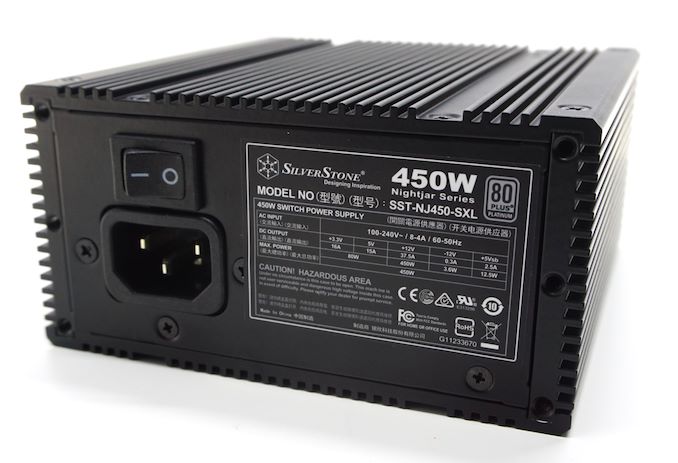
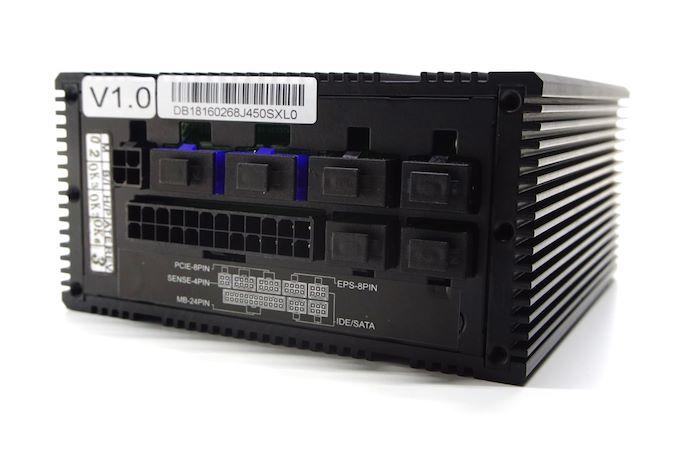
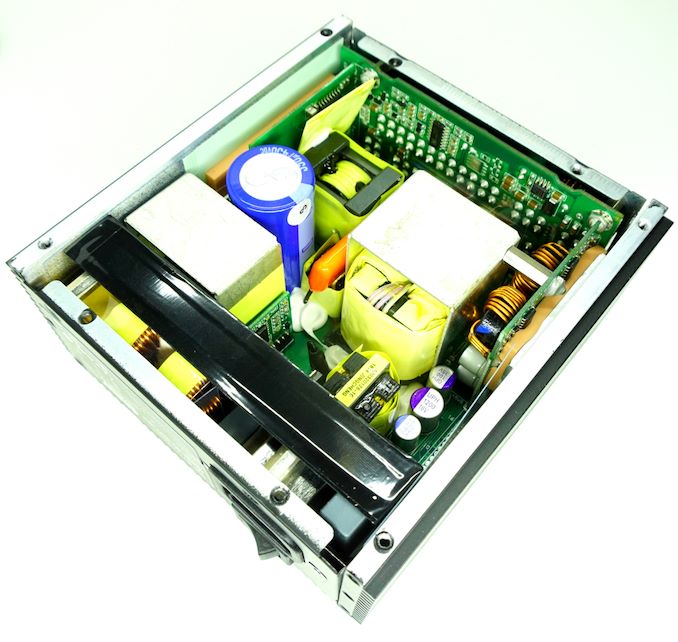
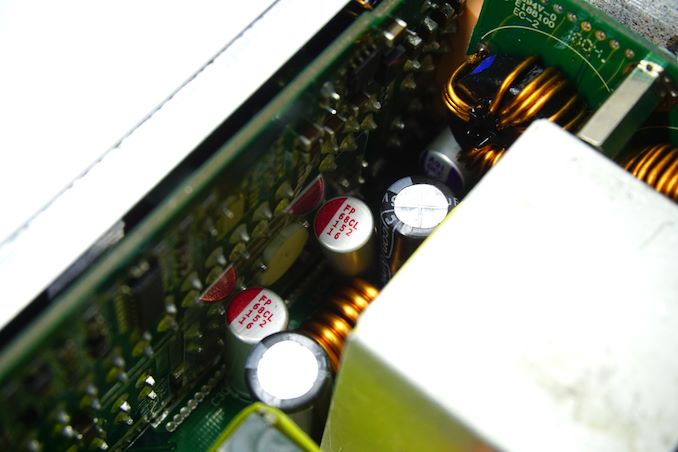
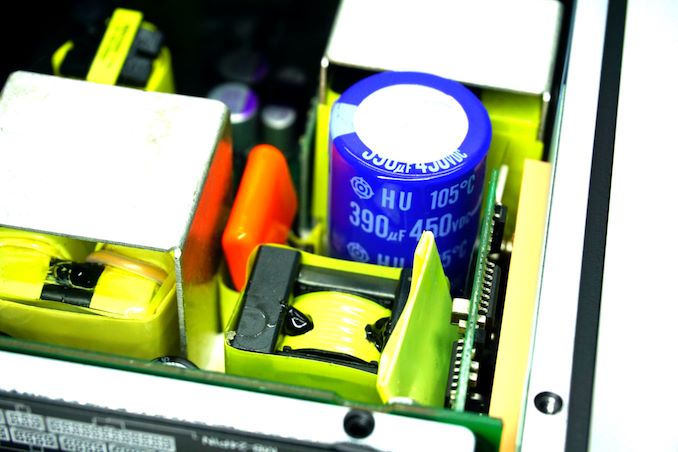
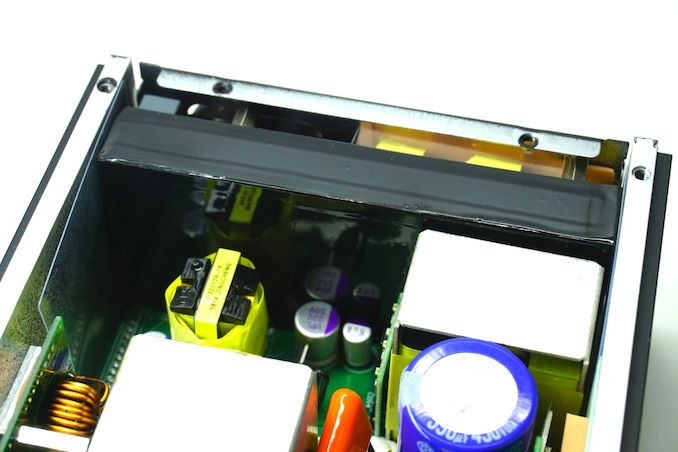








25 Comments
View All Comments
ingwe - Thursday, April 4, 2019 - link
This looks like a great PSU overall, but a passive PSU would make me pretty nervous about longevity.Exodite - Thursday, April 4, 2019 - link
I can only offer anecdotal support but I don't think you should worry about that, as long as the PSU itself is of good quality.I've been using the same Seasonic SS-FL460 (a fanless 460W, Gold-rated unit) since 2011 and while it's still powering the same i7 2600K I bought along with it it's scaled perfectly all the way up to a Vega 56, 4 HDDs and a SSD.
I don't game 24/7 by any means but even when stressing the unit as far as my setup allows (Prime95 + FurMark) it doesn't get particularly warm.
Unfortunately my particular unit isn't the perfect example of the benefits of fanless PSUs as it has some audible electrical noise under particular loads, so there's that. :)
jeremyshaw - Thursday, April 4, 2019 - link
Audible electrical noise is the exact reason I sold off my last Seasonic passive PSU. Mine made more noticeable noise than the fan did on another Seasonic PSU. Unacceptable, IMO, so I actually haven't bought another Seasonic since then (apparently a good choice, since they have since languished in PSU design, even if their quality remains reasonably high).Exodite - Thursday, April 4, 2019 - link
Completely understandable.I'm in the market for a new desktop later this year and if I end up replacing the chassi and PSU as well it probably won't be with a fanless model. Not because of any issue with passive cooling but rather the noise.
I'm still interested in Seasonic primarily I admit but since I value silence and the electrical noise of the new models are an unknown to me I'm inclined to go with a traditional solution.
FreckledTrout - Thursday, April 4, 2019 - link
I have a Seasonic Prime Ultra 850 Titanium SSR-850TR in my desktop build with a Ryzen 1800 and a GTX 1070. Having 850 watts its complete and utter overkill but it's basically fanless unit in hybrid mode for 99% of my usage and being Titanium I don't lose much efficiency running it at 25-40% of max wattage. It also has zero electrical noise that can make out even when I put me ear up to it with the fan not running I hear nothing.Exodite - Thursday, April 4, 2019 - link
Thank you, that's good information!If I do switch PSUs it's likely going to be a Titanium unit, for the 10% efficiency minimum. Hitting ideal efficiency under load is usually easy enough at any load from 25-100% but I'm hoping to improve my efficiency at idle and basic desktop use too.
A 650W Titanium unit should still be 90% efficient at 65W and that's not an unrealistic figure at the desktop, I think?
At least that's about what I'm seeing now, though obviously a more modern platform may well draw less power.
daniel78R - Thursday, April 4, 2019 - link
I have a Corsair SF600, in a FractalDesign Node 202 powering a Ryzen 1600X (with Scythe Big Suriken - modified) and GF 1060 and unless I start a game, the PSU does not start the fans, and even when it starts, it is way less noisy than CPU or GPU fans, and they are not very loud eithernagi603 - Monday, April 8, 2019 - link
> At least that's about what I'm seeing now, though obviously a more modern platform may well draw less power.Not necessarily, especially for GPUs. (1080 vs 2080 is quite a jump, 180 to 215W) The bump in core count has not resulted in lower idle draws either.
emn13 - Wednesday, April 10, 2019 - link
Although the electrical noise is major irritant for those that suffer from it, it's by no means universal, and it's not just one or two manufacturer's that have this problem. I'm pretty sure it's also not even really model-specific in the sense that even within the same model some batches are problematic, and other's aren't.Which means you might want to simply resign yourself to trying several ones, and sending bad ones back, rather than relying on trying to divine some pattern from the online reviews, many of which don't mention this at all.
tonyou - Sunday, April 7, 2019 - link
PSU electrical noises are usually high frequency noises and travel by air, so with NJ450-SXL's external aluminum heatsink shell having no vents, it actually helps reduce those noises better than any PC power supply ever could.If silence is your priority, you should give NJ450-SXL a try.